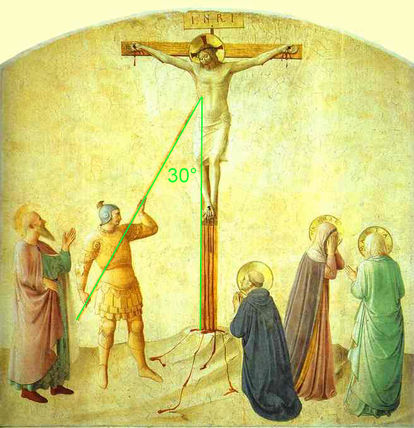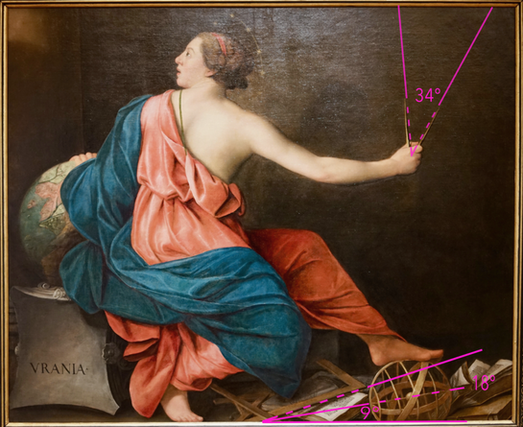
PICTORIAL
COMPOSITION
Preferential angles of painters
For painters, an angle or a number does not designate a quantity, it rather expresses a quality.
Tools, sticks, swords form angles that can be read directly on a painting, as with the Jacques-Lois David below, where the swords cross each other and therefore form angles.

With this scene from Jacques-Louis DAVID, we can directly record the angles of the intersecting swords: 12 ° and 18 ° and 40 °.
Other times, by extending beyond the visible part of the sticks, as below with this Fra Angelico, a 45 ° angle is revealed.

In this fresco by Fra Angelico, Christ is framed by a reed and a stick. By extending their directions they cross at an angle whose value is 45 °.
I admit that it is not necessarily very enticing, nor very glamorous to measure angles in a painting. But with a little patience you will understand how I came to discover with the pictorial archeology that the painted characters relate to each other through the line of their eyes, their extended looks, precisely with these angles carefully selected by generations of painters.
I have understood, thanks to my databases, that certain angle values recur more often than others and that they seem to mean something.
For example, 30 ° and 60 ° are the angles of the Star of David, 36 ° is that of the famous Pentagrame, the five-pointed star.
So I left like an explorer at the bottom of museums in search of all the angles that I could identify, angles that everyone can see indisputably in a painting.

Measures in the New MBA Dijon with an electronic bracket.
Photo Pascal Meyer
Painters' angles always have integer values, with no decimal places after the decimal point. This certainly comes from Greek philosophy where the first notions of pictorial composition were born. The Greeks claimed that only one whole number could not reflect the unity of the cosmos. For them, it was inconceivable to use a number followed by a fraction. In another chapter I would speak of a remarkable exception which confirms this rule, introduced by the Christian religion with the iconography of dragons and devils.

Mesures sur photo avec un ordinateur : ici 18° et 30°
Some paintings, like these by Bernardo DADDI and Albrecht DURER, have many angles that can be picked up with oars, masts, ropes, books. In addition, these angles meet the FIRST RULE OF PAINTERS: the visible lines point in the distance a part of the body of a character.

In this "Arrival of St Ursula" by Bernardo Daddi - 1330 - it is the eyes which are mainly pointed by the lines of the angles because the characters discover the city of Cologne.

the angles given by the books point to the eyes and fingers of the first rule of painters.
Albrecht Dürer - Jesus among the doctors - 1506 - traced © gm
The second stage of the archaeological process consists in bringing together the observations of these visible angles in the works, without interpreting them. So I created this database containing all the elements useful for identifying these angles.

Partial view of the database on the preferred angles of painters - © GM
From this database, it appears that certain angles are used more often than others, so I have grouped them in a simple diagram, using specific colors to differentiate them (there is no particular symbolism about of these colors):
According to my observations, the preferred angles of the painters would be in order of appearance:
18 ° - 36 ° - 30 ° - 9 ° - 45 °


There would be much to say about the preference of these five angles, which we find in geometric figures known since ancient times. They had a special meaning for mathematicians but also for philosophers - whose disciplines were not separated. For example, we can show that these five angles come from three stars which constitute the basis of philosophical teachings. 90 ° and 45 ° come from the octagon formed by two squares. On the other hand, 9 °, 18 ° and 36 ° come from the 5-pointed star, the Pentagrame. And finally, 30 ° comes from the Star of David formed by two triangles.
Do you know the names of the angles given by the builders of temples and cathedrals?
- The silver angle for the 18 °
- The royal angle for the 30 °
- The sublime angle for 36 °
- The right angle for 90 °
It is not only rectilinear objects that determine angles in paintings; characters' fingers are often drawn in remarkable angular language. Below, in this Bernardo Luini, pupil of Leonardo da Vinci, the main symbolic angles of painters are presented in the game of fingers according to the first rule of painters.
Bernardo Luini - Jesus among the doctors - 1515 - National Gallery - © GM - P mouse over the photo enough to see the angles.
It is instructive to note that often the extended angles respond to the functioning of the first rule of painters: to point to one of the twelve symbolic parts of the body of a character.
With the angles and straight lines that point to a part of the body of the characters, we have here the outline of an open visual system. Indeed, a line offers a reading direction, and an angle opens the gaze in two directions. These objective investigations propose not to limit the viewer's gaze in closed geometric figures.
The operation of this angle rule is like that of the first rule:
SIMPLE, VERIFIABLE, REPRODUCIBLE. There is again no need to develop personal projections that would show angles or composition geometry where there are none!
Anthology of visible angles
Do not hesitate to leave your comment, your questions at the bottom of the page, my pleasure is to be able to exchange with you on the pictorial composition. Thank you.
Guy MAUCHAMP
Work protected by copyright © guymauchampU79J1B9 and a deposit at the SGDL.










